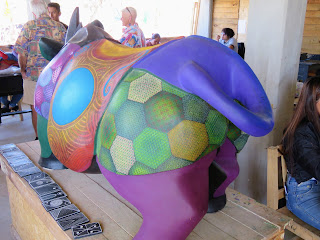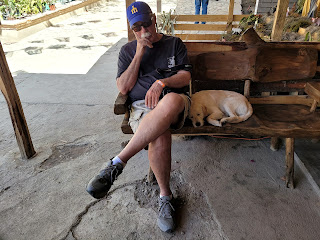Our last day's tours started with a van ride to a family's workshop where Oaxaca’s famous black pottery is created. This black pottery is found in only two places in the world - in Oaxaca and in New Mexico. Oaxaca is the location where Doña Rosa discovered the method of rubbing the unfired clay pots with a quartz crystal which then gives the black pottery a shiny finish. Barro negro pottery ("black clay") can be fired with the shiny finish or with a matte finish.
 |
| It starts with a blob of clay. |
Our potter was the grandson of Doña Rosa and he created an amazing pot from a clay blob to a pot ready to fire with step-by-step demonstrations. One interesting point is that the pot was spun on two plates placed bottom to bottom allowing the potter to turn the clay by hand. They do not use any kind of mechanical device to turn the pot (or for anything else), just their hands. The pot, when he finished was perfectly round! Wow!
After he spun the pot, he then used bamboo knives to cut an intricate design into the vessel. Once that was done he used a quartz crystal and rubbed the exterior of the pot, giving it the famous reflective sheen.
 |
| The clay is form into a crude pot. |
The finished pot will then be fired in an underground furnace, hardening the clay. In this part of the process the temperature and humidity plays a large role. It takes an expert to create these special items.
The final part of the tour was when we were turned loose in the gallery to purchase way too many finished gifts.
 |
| The pot blob is placed on two plates. |
 |
| The pot is formed. |
 |
| The lip is then placed on the pot and formed. |
 |
| The pot is rubber with a crystal. |
 |
| The design is then cut. |
 |
| The finished pot ready for firing. |
 |
Underground furnace where the
clay creations are fired. |
There have been so many interesting stops and wonderful places to explore on this trip to the Mexican highlands. It is hard to pick a favorite. To me the most intriguing stop was in
San Martin Tilcajete where we got to see the famous Alebrijes being created in a workshop where professional carvers and painters teach their techniques to young interns who have been accepted into this community.
 |
| A welcoming Aelbrijes greets us as we arrive. |
At this workshop, we were able to see paintings, carvings, creative crafts and much more, all in the style of the Aelbrijes. The traditional Aelbrijes are wood carvings that combine two animal spirits, the Tona (the animal spirit when you are alive) and the Nahual (the animal spirit when you are dead). The artist carves these spirit forms into a very interesting and detailed carving.
Linda's tona comes from her birth date and month, so her animal spirit is the Armadillo. The year she was born gives her a Nahual represented by a monkey. Her Aelbrijes would possibly be a wooden carving of a monkey's head with the body of an armadillo, or something like that. My tona is a mockingbird with a Nahaul of a deer. The artist who is commissioned to create the carving would chose how the tona and nahaul are combined through a process of meditation and spiritual enlightenment, along with the input of the individual.
 |
Three carvers working on different pieces, each
in different stages of the process. |
Once the carving is complete and the wood has been dried, filled, and sanded (this alone can take many months), the artist paints the design onto the wood. This design is very colorful and amazingly detailed. Artist strokes with two hair bristles are not uncommon. I was amazed how these artists can paint such delicate designs.
The entire process can take many months or even years. The results are amazing and can be very expensive. We were told that the large rhinoceros in the photos below is nearly complete. It will be finalized and then flown to Dubai in the United Arab Emirates and entered into a famous art competition.


























~2.jpg)




No comments:
Post a Comment